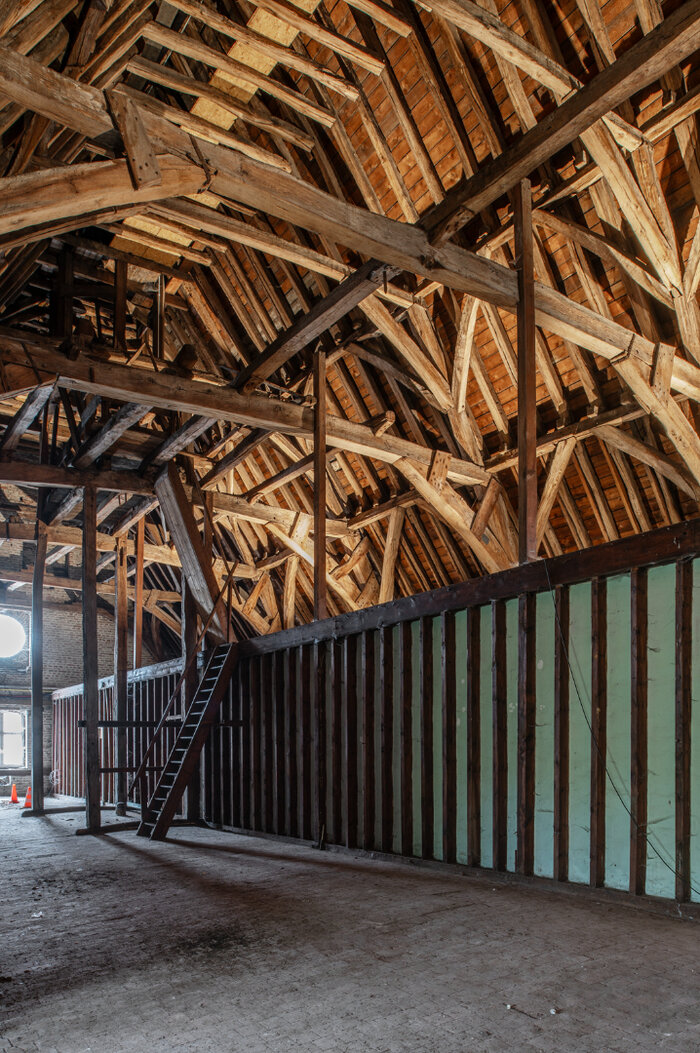

The 13th century
The St. John's hospital was founded some time in the 13th century, but the exact year is unknown. The earliest mention of the hospital is to be found in a charter of the magistrates of Damme, dating from 1249. Damme itself was built a century earlier on the transverse dike at the Zwingeul. This fishing village grew rapidly, and was connected to Bruges via a canal, which transformed it into a transshipment port. In 1180, Damme was granted city rights.
The St. John's hospital is one of the many hospitals that emerged in the 12th and 13th centuries. It was a period characterised by a surge in population, urbanisation and the gradual emergence of the bourgeoisie. This created a need for shelter for itinerant merchants, pilgrims and vagrants, as well as for city dwellers who suffered in old age or from illness. The infirmary was under the authority of the magistrates of Damme, but was managed by a monastic order of Augustinian nuns (and monks up until 1584).

Monumental attic
A well-preserved civic building like this from the Middle Ages is very rare. The main building is an early Gothic construction of Romanesque proportions. It consists of a brick construction, directly on the street, with two floors, a high gable roof and a pointed facade with flat shoulder portions. The façade contains rectangular window openings with straight lintels and semicircular arch fields, which would be bricked up at a later date. The floors are separated by drip-courses made of Tournai stone.
The attic of the hospital ward is more than 30 metres long, 14 metres wide and is covered by a monumental roof structure with 57 pairs of rafters. A study of the year rings on these beams shows that the trees were felled around 1270, which again makes the early chronology of the hospital uncertain.

15th-17th centuries: far-reaching renovations
For two centuries, little changed in the hospital. In the 15th century, there seems to have been a revival for the town on the Zwin, thanks to right to stockpile herring and wine. A new, smaller town hall was built and a priory established. The St. John's hospital expanded with the addition of a small wing on the west side. Although Damme fell into disrepair in the 16th century and gannets came to plunder the churches, the hospital was once again expanded. There would be a new hospital ward on the east side and a kitchen on the west side.
In the 17th century, the hospital underwent major renovations. The main building, originally one ward, was divided into, among other things, a chapel, a sacristy, a meeting room and consultation rooms. Four pointed-arch windows in the oldest wing were replaced with baroque windows; the chapel got a baroque entrance, and the roof got a bell tower. For several decades, the complex also had a brewery, but the groundwater turned out to be too briny to brew beer. At the beginning of the 17th century, Damme was converted into a fortified town and the hospital chapel also served as a garrison chapel.

18th and 19th centuries: revolutionary changes
As a result of Napoleon's reforms in 1796, all places of worship and similar institutions were placed under the Board of the Civic Almshouses, a forerunner of today's Public Centres for Social Welfare. However, the nuns were allowed to stay. The landscape of Damme changed dramatically due to the construction of the new canal between Bruges and the Scheldt, right across the corn market.
During the 18th and 19th centuries, new buildings were constructed, including a barn and a seamsters' room. A new natural stone tiled floor would be laid in the loft and the stairwell would be fully reconstructed. These major works took place at the end of the 19th century. In 1875, there would be a rest home on the north side, designed by Pieter Buyck, and, on the south side, 1908 saw the new St. Margarethagodshuis, for which part of the walled vegetable garden was sacrificed. The original hospital was transformed into an archaeological museum displaying devotional objects, art works and work utensils.

1984-2014
In 1984, an extensive programme of restoration and renovation got underway. The north wing dating from 1875 was demolished and replaced by an elevated rest home section, designed by Frans Van Cleven, which adjoins the 13th-century main building. The passage leading from the chapel to the kitchen, along with the west wing, were renovated. A further host of repairs and refurbishments were carried out.
Eventually, the museum closed its doors to the public. The Augustinian sisters continued to run OCMW Damme's ‘Rustoord Sint-Jan‘ retirement home throughout this period. In 2014, the elderly residents moved out to Sijsele, and the complex fell into disuse.
Source: Agentschap Onroerend Erfgoed